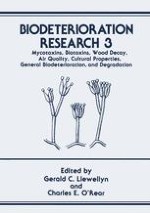1990 | OriginalPaper | Buchkapitel
Cytotoxicity of Fusarium moniliforme Metabolites
verfasst von : Cecile E. F. La Grenade, George A. Bean
Erschienen in: Biodeterioration Research
Verlag: Springer US
Enthalten in: Professional Book Archive
Aktivieren Sie unsere intelligente Suche, um passende Fachinhalte oder Patente zu finden.
Wählen Sie Textabschnitte aus um mit Künstlicher Intelligenz passenden Patente zu finden. powered by
Markieren Sie Textabschnitte, um KI-gestützt weitere passende Inhalte zu finden. powered by
There is little doubt that the genus Fusarium constitutes one of the most important groups of toxigenic fungi. Many species of Fusarium produce an array of secondary metabolites which elicit dissimilar physiological and pharmacological responses in plants and animals. Many of these are mycotoxins. More than half of the 37 trichothecenes that have been isolated are elaborated by Fusarium species (Vesonder and Hesseltine, 1985). Fusarium moniliforme is one such member of this genus. It is a common, ubiquitous fungal pathogen to many plants, including corn (Zea mays); it causes corn stalk and ear rot diseases (Ayers et al., 1972). The range of secondary metabolites produced by F. moniliforme includes mycotoxins, antibiotics, phytotoxins and phytoalexins. Although the fungus is known to be internally seed borne in apparently healthy corn kernels (Foley, 1962; Marasas et al., 1979), it has been correlated with increased human esophageal cancer risk in China and Southern Africa (Marasas et al., 1984), and has been implicated as the causative agent of equine leucoencephalomalacia (ELEM) (Marasas et al., 1976). Both moniliforme (Cole, 1973) and Fusarin C (Wiebe, 1981) have been rejected as the causative agent of ELEM. Direct and unequivocal evidence linking a mycotoxin of F. moniliforme with ELEM has been shown by Marasas et al., 1988.
